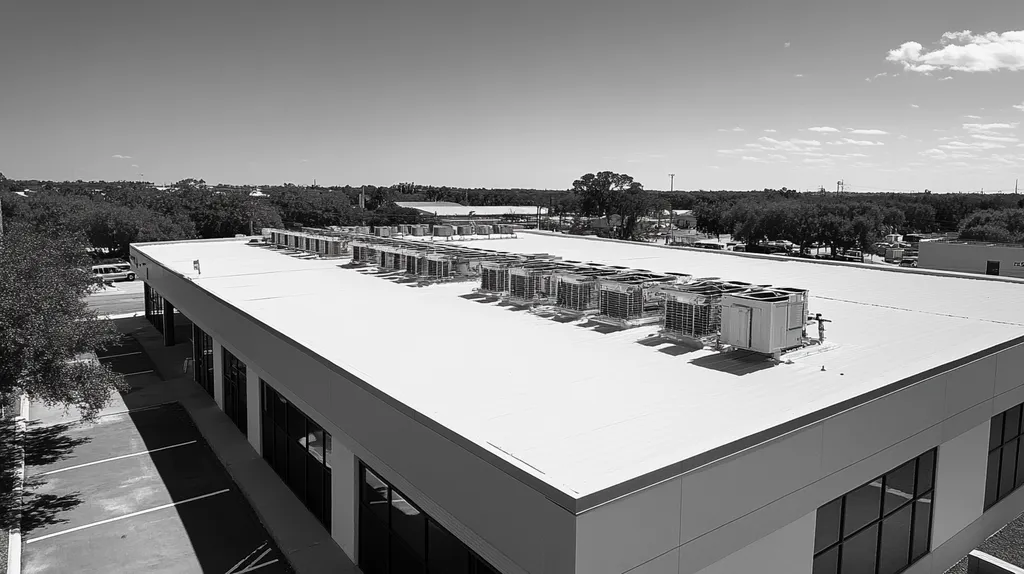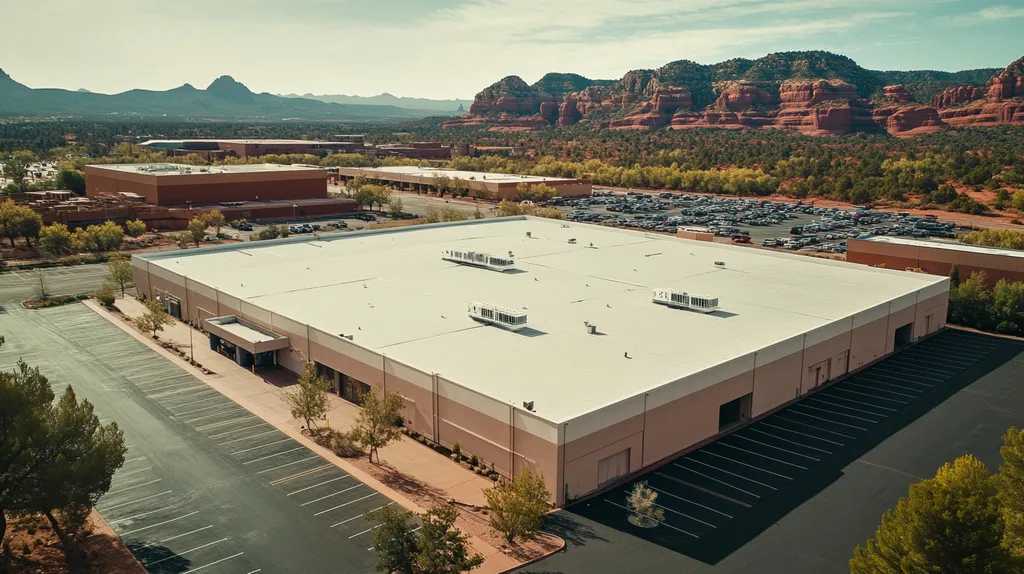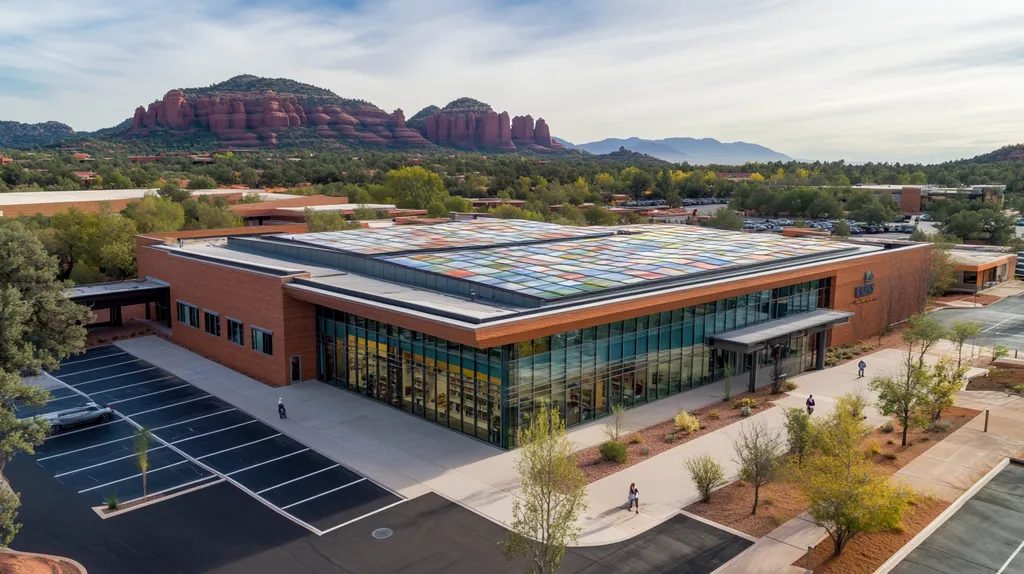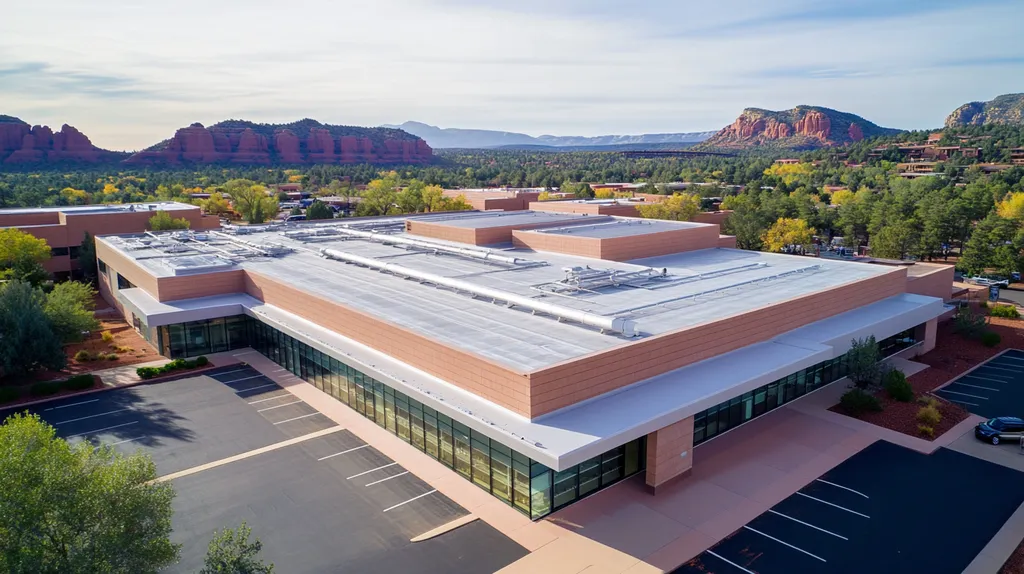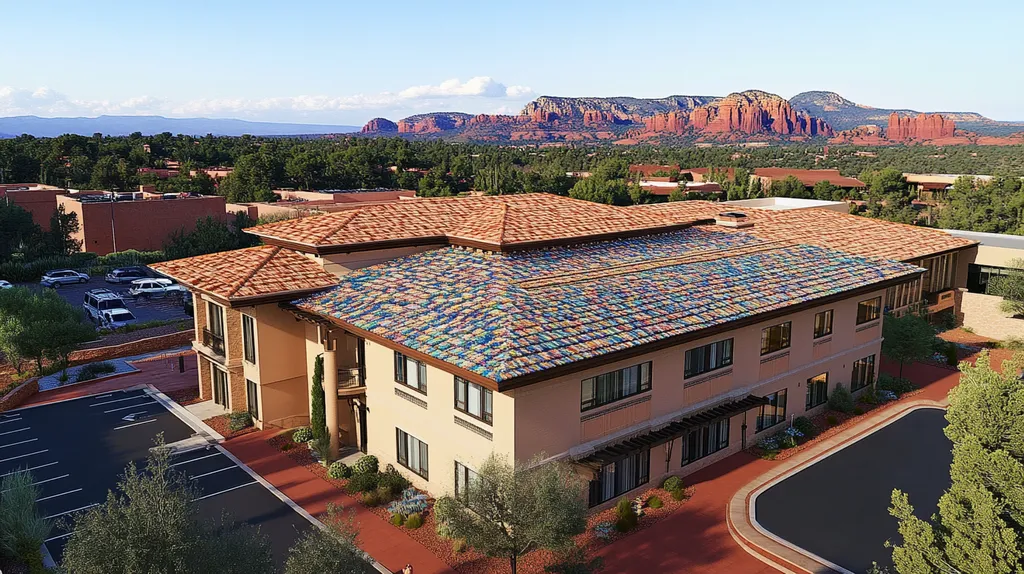Commercial property owners hemorrhage millions annually through inefficient roofing decisions, yet most treat roof coatings like expensive cosmetic fixes rather than profit-generating investments.
Industry data reveals that properly calculated coating ROI consistently delivers 200-400% returns over project lifecycles, transforming aging roof liabilities into cash-flowing assets through strategic application.
The difference between coating success and expensive disappointment lies in understanding the financial mechanics that separate legitimate opportunities from marketing mirages masquerading as building improvements.
SECTION 1: THE BASICS EXPLAINED
While property managers obsess over squeaky hinges and flickering lights, their roofs silently hemorrhage money through energy waste and emergency repairs. Commercial roof coatings offer a deceptively simple solution that can transform a building’s biggest liability into a profit center.
Yet most facility managers treat coatings like expensive makeup for aging roofs rather than recognizing their true potential as financial instruments. Understanding the mechanics behind coating ROI separates savvy property stewards from those who perpetually chase costly band-aid solutions.
What It Is (In Plain Language)
Think of commercial roof coating as a liquid insurance policy that hardens into protection. This isn’t paint—it’s a sophisticated polymer system that bonds molecularly with existing roof surfaces to create an entirely new protective layer.
Modern coatings come in three primary flavors: acrylic (the budget-friendly workhorse), silicone (the ponding water specialist), and polyurethane (the traffic-resistant champion). Each formula targets specific roof ailments while delivering the same core promise: extending useful life without the drama of a full replacement.
The beauty lies in the application method—liquid goes on easy, but cures into a seamless membrane that laughs at weather extremes. No tear-off, no dumpsters, no construction chaos that sends tenants fleeing.
Quality coatings can add 10 to 20 years of service life to aging roof systems. That’s potentially two decades of deferred replacement costs while maintaining watertight integrity.
The real magic happens at the molecular level, where modern polymer chemistry creates bonds stronger than many original roofing materials. It’s renovation disguised as maintenance.
Why It Matters (To Your Building)
Every commercial roof operates as either a profit center or a money pit—there’s rarely middle ground. Leaky, inefficient roofs create cascading costs that ripple through every building system and tenant relationship.
Energy bills tell the brutal truth about roof performance, with black, deteriorated surfaces turning buildings into solar ovens. Reflective coatings can slash cooling costs by 20-40% in sun-drenched climates, transforming utility bills from budget nightmares into manageable line items.
The ROI equation becomes compelling when building owners calculate total financial impact: [(Energy savings + avoided repairs + extended roof life) ÷ coating investment] × 100%. Most projects achieve positive returns within 3-7 years while delivering benefits for decades (source: Calculate My Roof).
Tenant satisfaction soars when leaks disappear and interior temperatures stabilize. Happy tenants renew leases, unhappy ones lawyer up or leave—both outcomes carry hefty price tags.
Insurance companies increasingly reward proactive roof maintenance with premium discounts, recognizing that coated roofs file fewer claims. Some carriers offer 10-15% reductions for documented coating programs.
How It Works
Roof coatings succeed through elegant simplicity: they create seamless barriers where traditional roofing systems fail at seams, joints, and penetrations. Liquid application means zero gaps, unlike mechanical fastening systems that create thousands of potential failure points.
The curing process transforms liquid coating into a rubber-like membrane that moves with the building structure. Thermal expansion and contraction—the silent killers of rigid roofing materials—become non-issues when protective layers can stretch and recover.
Reflective pigments embedded in coating formulations redirect solar energy skyward rather than absorbing it into building structures. Surface temperatures can drop 50-80 degrees compared to aged, dark roofing materials.
Application typically requires 2-4 days depending on building size and weather conditions. Most tenants never realize major roof work occurred above their heads—the ultimate compliment for any building improvement project.
Properly maintained coatings deliver consistent protection for 10-20 years with periodic recoating extending service life indefinitely. It’s like having a roof that renovates itself on schedule rather than failing catastrophically.
SECTION 2: PRACTICAL APPLICATIONS
Smart facility managers recognize that roof coatings aren’t one-size-fits-all solutions—they’re precision instruments requiring strategic deployment. The difference between coating success and expensive disappointment lies in understanding exactly when, where, and how these liquid shields perform their financial magic.
Real-world applications reveal patterns that separate profitable investments from costly mistakes. Knowing these patterns transforms coating decisions from educated guesses into calculated moves that consistently deliver returns.
Common Uses & Examples
Retail chains discovered coatings’ secret weapon status when faced with aging big-box stores across sun-baked territories. A major grocery chain applied white elastomeric coating to 47 stores, slashing air conditioning costs by 30% while postponing $12 million in roof replacements.
Manufacturing facilities embrace silicone coatings as the ultimate ponding water nemesis. Those stubborn puddles that mock traditional roofing materials become irrelevant when silicone creates surfaces that shed water like duck feathers.
Office complexes leverage reflective coatings as tenant retention tools, transforming sweltering top floors into comfortable workspace. Lower utility bills become powerful lease renewal incentives when property managers can demonstrate measurable comfort improvements.
Cold storage warehouses use specialized coatings to combat condensation demons that corrode metal roofing from within. These applications prevent the slow-motion disasters that turn profitable food distribution into expensive mold remediation projects.
Schools and hospitals choose coatings for their stealth installation advantage—no dumpsters, no noise, no operational disruptions. Critical facilities maintain full function while roofs receive life-extending treatment above occupied spaces.
When You Need It Most
Timing separates coating heroes from coating zeros, with optimal windows occurring during specific roof aging phases. Surfaces showing chalk residue, minor cracking, or UV-induced color fading signal perfect intervention moments—early enough to prevent structural issues, late enough to justify investment.
Weather windows matter more than most facility managers realize. Spring and fall applications allow proper curing without temperature extremes that compromise adhesion or create application nightmares for contractors.
Budget cycle coordination transforms coating projects from emergency expenses into planned investments. Properties approaching major capital expenditure years benefit from coating deferrals that buy time for better financial positioning.
Lease renewal seasons create coating urgency as tenant negotiations hinge on building performance promises. Proactive coating demonstrates management competence while preventing moisture intrusion that could torpedo occupancy rates.
Energy audit revelations often trigger coating decisions when thermal imaging exposes roof-related efficiency losses. The ROI equation becomes compelling: [(Energy savings + avoided replacement costs) ÷ coating investment] × 100% typically yields returns within 8-15 years based on local market conditions (source: Calculate My Roof).
Interactions With Other Systems
Roof coatings play surprisingly well with building systems when facility managers understand the compatibility dance. HVAC units benefit from cooler roof surfaces that reduce equipment stress, while reflective coatings can blind nearby solar panels if positioned carelessly.
Insulation systems become coating allies, with reflective surfaces reducing thermal cycling that ages foam boards and fiberglass batts. However, vapor barriers require careful evaluation to prevent moisture entrapment that transforms insulation into expensive soggy messes.
Drainage systems interact with coatings in ways that mystify inexperienced applicators. Proper surface preparation ensures coating doesn’t create dams at roof drains, while ponding-resistant formulations prevent premature failure in chronically wet areas.
Electrical conduits and penetrations demand special attention during coating application. Overspray on junction boxes creates maintenance headaches, while inadequate sealing around penetrations allows moisture infiltration that defeats coating purposes.
Fire suppression systems benefit from coating compatibility checks that prevent chemical interactions. Some coating formulations can degrade certain gaskets or seals, turning routine maintenance into expensive component replacement projects.
SECTION 3: KEY TERMINOLOGY DECODED
Facility managers routinely stumble through ROI calculations like tourists navigating foreign countries without phrasebooks. Coating contractors throw around terms like “mil thickness” and “solar reflectance” while property owners nod knowingly, secretly wondering if anyone actually speaks plain English anymore.
The financial stakes of terminology confusion run deeper than bruised egos at budget meetings. Misunderstanding key metrics can transform profitable coating projects into expensive misadventures, while fluency in roofing vernacular unlocks hidden value in vendor proposals and performance specifications.
Essential Terms Explained
Return on Investment (ROI) serves as the universal translator between roofing improvements and boardroom approval. This deceptively simple calculation—[(Total Benefits – Total Costs) ÷ Total Costs] × 100%—separates profitable projects from corporate money pits.
Net Present Value (NPV) brings future dollars back to reality by accounting for inflation and opportunity costs. A coating project promising $50,000 in savings over 15 years isn’t worth $50,000 today—it’s worth considerably less when smart money could earn returns elsewhere.
Life Cycle Cost Analysis (LCCA) plays the long game by tallying every expense from installation through eventual replacement. This comprehensive approach often reveals coating projects that appear expensive upfront but deliver superior value across extended timeframes.
Energy savings represent the most tangible coating benefit, typically measured as reduced cooling costs during peak summer months. Reflective coatings can slash air conditioning expenses by 10-40%, depending on climate conditions and existing roof performance.
Deferred replacement costs capture the elephant-sized savings hiding in plain sight. Extending roof life by 10-15 years through strategic coating delays major capital expenditures while maintaining operational integrity.
Industry Jargon Translated
Solar Reflectance Index (SRI) measures how effectively surfaces reject solar heat, with higher numbers indicating cooler roof temperatures. Think of it as sunscreen SPF ratings for buildings—higher values provide better protection against thermal punishment.
Mil thickness describes coating depth in thousandths of an inch, where proper application typically requires 10-20 mils for optimal performance. Too thin means premature failure; too thick wastes money without proportional benefits.
Elastomeric coatings stretch like rubber bands to accommodate thermal expansion and building movement. This flexibility prevents cracking that would compromise waterproofing integrity and defeat the entire investment purpose.
VOC content (Volatile Organic Compounds) affects both environmental compliance and worker safety during application. Lower VOC formulations may cost more initially but avoid regulatory headaches and potential health liabilities.
Ponding resistance determines coating survival in areas where water accumulates after rainfall. Standard coatings dissolve in standing water like sugar cubes, while specialized formulations laugh at persistent puddles.
Measurement & Units Simplified
Square footage calculations drive every coating project budget, but measurement mistakes can derail entire ROI analyses. Professional surveys often reveal 15-25% discrepancies compared to architectural drawings, turning estimated costs into expensive surprises.
Cost ranges from $0.25 per square foot for basic acrylic treatments to $5.00 per square foot for premium systems on complex surfaces. Understanding these variables prevents sticker shock and enables accurate budget planning for different performance expectations.
Annual maintenance savings average $0.25 per square foot according to industry data, creating predictable cost reductions that compound over extended coating lifecycles (source: SmartSeal). These seemingly modest amounts generate substantial cumulative benefits across large roof areas.
Kilowatt-hours (kWh) and British Thermal Units (BTUs) quantify energy consumption reductions that translate directly into utility bill savings. Converting these technical units into dollar amounts reveals coating projects’ most immediate financial benefits.
Payback periods typically range from 3-8 years for properly specified coating applications. Shorter timeframes indicate exceptional projects; longer periods suggest marginal investments that require careful evaluation against alternative improvement strategies.
SECTION 4: DECISION FACTORS
Facility managers who treat coating decisions like ordering office supplies discover why pennies and pounds refuse to play nicely together. The cheapest bid often delivers the most expensive education, while premium options sometimes promise Rolls-Royce performance for Honda applications.
Smart decision-making requires navigating cost mirages, performance promises, and durability claims that would make carnival barkers blush. Understanding these factors transforms coating selection from expensive guesswork into calculated investments that consistently deliver returns.
Cost Considerations
Sticker shock separates coating amateurs from seasoned facility strategists, but initial price tags tell elaborate lies about true investment costs. Basic acrylic coatings seduce budget committees with $0.75 per square foot price points, while premium systems demand $3.50 per square foot—yet the expensive option often costs less over time.
Labor expenses frequently dwarf material costs, especially when surface preparation requirements explode budgets. Cheap coatings demanding extensive prep work can triple total project costs, while premium formulations designed for minimal preparation deliver installation savings that offset higher material prices.
Hidden costs lurk in warranty exclusions, application weather windows, and compatibility requirements that transform simple coating projects into complex orchestrations. Some bargain formulations require perfect conditions and extensive surface modifications, creating scheduling nightmares that inflate final invoices.
The brutal mathematics of replacement deferral reveal coating ROI reality: full roof replacement can exceed $11.50 per square foot, while coatings extend roof life by 15-20 years, creating massive avoided costs that dwarf initial investments. Smart facility managers calculate total ownership expenses rather than fixating on upfront sticker prices.
Energy savings projections require careful analysis of baseline costs and reflectivity improvements from coating application. Moving roof reflectivity from 5-15% to 80-90% generates substantial cooling cost reductions that compound annually throughout coating service life (source: Talbot Companies).
Performance Trade-offs
Coating performance operates like a three-legged stool where reflectivity, durability, and weather resistance must balance perfectly—or everything topples spectacularly. Reflective champions that slash cooling costs sometimes sacrifice chemical resistance, while waterproofing warriors may absorb heat like solar collectors.
Elastomeric coatings promise rubber-band flexibility for thermal cycling but often demand sacrifices in dirt resistance or UV stability. Meanwhile, rigid protective systems offer superior chemical resistance while potentially cracking under thermal stress that would make flexible coatings yawn.
Regional climate conditions expose performance trade-offs with surgical precision, where desert installations punish UV-sensitive formulations while coastal environments corrode chemically-vulnerable systems. Hurricane-prone regions demand different coating DNA than snow-belt facilities dealing with freeze-thaw cycles.
Application complexity creates another performance dimension where user-friendly coatings may sacrifice ultimate protection levels. Single-component systems offer installation simplicity but rarely match the performance ceiling of carefully-applied multi-component alternatives.
Maintenance requirements vary dramatically between coating types, with some systems demanding annual inspections while others operate maintenance-free for decades. Understanding these service intervals prevents surprise costs that can torpedo ROI calculations.
Lifespan & Durability Factors
Coating lifespan predictions resemble weather forecasting—everyone claims accuracy while reality delivers surprising plot twists. Manufacturer warranties promise specific service lives, but environmental conditions, application quality, and maintenance practices determine actual performance timelines.
UV exposure intensity, temperature cycling frequency, and chemical pollutant concentrations create durability stress tests that separate coating pretenders from genuine performers. Desert installations face different aging mechanisms than industrial facilities dealing with chemical exposure or coastal properties battling salt air.
Application thickness directly influences durability, where thin coatings fail prematurely while excessive thickness wastes money without proportional longevity benefits. The sweet spot typically requires 15-25 mils for optimal performance, depending on substrate conditions and environmental exposure.
Surface preparation quality often determines coating success more than material selection, with proper cleaning and priming enabling average coatings to outperform premium systems applied over marginal substrates. Shortcuts during preparation create predictable failure patterns that destroy ROI projections.
Maintenance reduction becomes a major durability dividend, with quality coatings eliminating 60-80% of routine roof maintenance while preventing emergency repairs that disrupt operations and drain budgets. These avoided costs compound over time, creating substantial value beyond simple waterproofing benefits.
SECTION 5: COMMON CHALLENGES
Facility managers who assume coating application resembles painting their garage discover why optimism and thermoplastic polymers make terrible bedfellows. Industry data reveals that 40% of coating projects fail to deliver promised ROI within projected timeframes, transforming profit centers into expensive lessons in material science.
The culprits rarely involve coating chemistry—they stem from predictable human errors during planning, application, and maintenance phases. Recognizing these performance assassins before they strike separates coating success stories from budget committee nightmares.
Frequent Problems & Solutions
Surface preparation failures top the coating catastrophe charts, where contractors skip cleaning steps to save time and create adhesion disasters instead. Oil residues, ponded water, and oxidized substrates sabotage molecular bonding faster than facility managers can say “warranty claim.”
Weather window violations plague rushed projects where schedule pressure overrides application science. Coating materials applied during temperature extremes or high humidity cure incorrectly, creating expensive do-overs that double initial investment costs.
Material mismatching transforms promising projects into chemical incompatibility experiments with predictable outcomes. Silicone coatings over acrylic primers, elastomeric systems on ponding-prone areas, or reflective coatings in shaded locations deliver performance disappointments that mock initial ROI projections.
Solution strategies center on comprehensive pre-application audits that identify substrate conditions, environmental factors, and compatibility requirements. Professional contractors worth their safety harnesses invest 30-40% of project time in preparation phases that determine coating success.
Quality control checkpoints throughout application prevent minor issues from becoming major failures. Temperature monitoring, mil thickness verification, and cure time compliance create documentation trails that protect both contractors and building owners from performance disputes.
Warning Signs To Watch For
Visual distress signals announce coating failures long before complete system breakdown, yet most facility managers mistake early symptoms for cosmetic issues. Chalking, color fading, and surface crazing indicate UV degradation that compromises protective integrity within months of initial detection.
Blistering and bubbling reveal moisture entrapment or substrate incompatibility issues that spread like roofing cancer across treated surfaces. These seemingly minor imperfections create water infiltration pathways that destroy coating investment and underlying roof systems simultaneously.
Ponding water persistence in previously treated areas signals coating breakdown or improper material selection for specific drainage conditions. Standing water dissolves most standard coatings like expensive sugar cubes, requiring immediate intervention to prevent total system failure.
Interior temperature fluctuations or increased cooling costs during peak summer months indicate reflectivity loss that eliminates primary coating benefits. Energy bill increases often provide the earliest warning signs of coating degradation before visual symptoms become apparent.
The ROI calculation reveals coating distress through financial performance: [(Energy savings + maintenance reduction) ÷ coating investment] × 100%. Declining returns signal system deterioration requiring professional evaluation and potential remediation (source: CalculateMyRoof).
Preventative Approaches
Strategic coating selection based on comprehensive building assessments prevents 70% of common failure modes while optimizing performance characteristics for specific environmental conditions. Climate analysis, substrate evaluation, and drainage assessment inform material choices that align with actual service conditions rather than generic specifications.
Contractor vetting separates qualified applicators from bargain hunters wielding paint rollers and ambitious promises. Certified installers with manufacturer training credentials deliver consistent results that justify premium pricing through superior performance and warranty coverage.
Maintenance scheduling transforms reactive crisis management into proactive asset protection, with annual inspections identifying minor issues before they become major expenses. Simple cleaning protocols and drain maintenance prevent 90% of premature coating failures while extending service life beyond manufacturer projections.
Documentation protocols create accountability chains that protect coating investments through detailed application records, weather conditions, and material specifications. These paper trails become invaluable during warranty claims or performance disputes that could otherwise void investment protection.
Performance monitoring through energy bills, roof temperature measurements, and visual inspections provides early warning systems that preserve ROI through timely intervention. Smart facility managers treat coating maintenance like insurance premiums—small investments that prevent catastrophic losses.
SECTION 6: NEXT STEPS & RESOURCES
Facility managers who survive coating education bootcamp often stumble at the finish line, armed with knowledge but paralyzed by implementation anxiety. The gap between understanding ROI theory and executing profitable projects claims more coating dreams than weather exposure and substrate incompatibility combined.
Smart property stewards recognize that coating success depends less on perfect product selection than on asking surgical questions, following battle-tested standards, and maintaining learning momentum. The difference between coating champions and expensive cautionary tales lies in methodical preparation rather than wishful thinking.
Questions To Ask Providers
Contractor interviews separate coating professionals from paint slingers masquerading as roofing experts, but most facility managers ask softball questions that reveal nothing useful. Skip the “how long have you been in business” pleasantries and demand specifics about substrate preparation protocols for your exact roof type.
Warranty terms reveal contractor confidence levels and manufacturer backing in ways that smooth sales presentations cannot. Ask for written guarantees covering both material performance and labor quality, then verify these promises directly with coating manufacturers who often maintain approved applicator databases.
Reference projects should match your building type, climate conditions, and performance expectations rather than impressive-sounding installations on completely different structures. Demand energy bill comparisons and maintenance cost documentation from similar facilities that demonstrate actual ROI rather than theoretical projections.
Weather window requirements and application scheduling flexibility expose contractors who understand coating chemistry versus those who wing it based on paint experience. Professional applicators carry contingency plans for temperature swings and humidity spikes that amateur operators treat as unfortunate surprises.
The ROI equation becomes tangible when contractors provide detailed cost breakdowns: [(Energy savings + avoided repairs + extended roof life) ÷ total project investment] × 100%. Quality providers welcome these calculations because their work consistently delivers positive returns (source: Calculate My Roof).
Industry Standards & Guidelines
Standards organizations function as coating industry referees, establishing performance benchmarks that separate legitimate products from marketing mirages. ASTM International publishes testing protocols that reveal how coatings actually perform under controlled conditions rather than relying on manufacturer claims.
The National Roofing Contractors Association (NRCA) maintains installation guidelines that prevent 80% of common application failures through standardized procedures. These documents read like insurance policies against contractor shortcuts that destroy coating investments through improper surface preparation or weather violations.
Cool Roof Rating Council (CRRC) databases provide verified reflectance and emittance values that enable accurate energy savings calculations. Facility managers who specify CRRC-rated products avoid the guesswork that transforms energy reduction promises into utility bill disappointments.
International Code Council standards increasingly influence local building requirements, with energy codes demanding specific reflectance values for commercial roofing systems. Understanding these requirements prevents costly retrofits when coating projects fail to meet evolving regulatory expectations.
Manufacturer specifications should align with applicable standards rather than creating proprietary performance metrics that resist independent verification. Products backed by recognized testing standards deliver predictable results that support reliable ROI projections.
Further Learning Simplified
Coating education never ends because technology advances, climate patterns shift, and building performance expectations evolve faster than most facility managers can track. The Roof Coatings Manufacturers Association (RCMA) offers webinars that decode emerging formulations without requiring chemistry degrees to understand practical implications.
Trade publications like Professional Roofing Magazine publish case studies that reveal real-world coating performance across different climates and building types. These articles provide ammunition for budget meetings where skeptical executives demand proof that coating investments deliver promised returns.
Regional roofing associations host educational events where facility managers can network with peers facing similar coating challenges and solutions. Local knowledge often proves more valuable than generic industry advice when dealing with specific climate conditions or contractor availability.
Energy audit professionals increasingly understand coating interactions with HVAC systems and overall building performance. These specialists help facility managers quantify total building benefits that extend beyond simple roof protection into comprehensive operational improvements.
Online ROI calculators and energy modeling tools continue improving in sophistication and accuracy, enabling facility managers to evaluate coating scenarios without hiring expensive consultants. Smart property stewards bookmark these resources for quick decision support when coating opportunities arise unexpectedly.
The Bottom Line
Commercial property owners who continue treating roof coatings as cosmetic band-aids rather than profit-generating investments leave millions on the table annually while their competitors collect 200-400% returns on properly calculated projects.
The mathematics remain brutally simple: energy savings, deferred replacement costs, and reduced maintenance expenses consistently outweigh coating investments when facility managers follow proven selection criteria and avoid common implementation pitfalls.
Time separates coating winners from expensive cautionary tales, with optimal roof conditions disappearing faster than budget approval cycles typically operate. Today’s minor surface deterioration becomes tomorrow’s structural replacement emergency, eliminating coating options entirely.
Smart facility managers recognize that coating ROI calculations aren’t academic exercises—they’re competitive advantages that transform aging roof liabilities into cash-flowing assets while less informed competitors hemorrhage money through emergency repairs and premature replacements.
The question isn’t whether coating investments deliver returns, but whether property stewards will act before profitable opportunities vanish into costly necessities.
FREQUENTLY ASKED QUESTIONS
Q. What is the ROI benefit of a commercial roof coating?
A. A roof coating acts like a liquid shield, extending service life and cutting energy waste. It defers costly replacements by 10 to 20 years while slashing cooling bills 20-40%, turning costly roofs into financial assets. Proper application means minimal disruption, making your building’s biggest expense work harder for you.
Q. When should I apply a commercial roof coating for best ROI?
A. Timing is everything—ideal windows are during early signs of roof aging like chalking or minor cracking and in mild seasons like spring or fall. Planning around budget cycles and lease renewals transforms treating roofs into strategic money moves rather than emergency splurges, maximizing your coating’s financial magic.
Q. What key terminology should I understand about industrial roof ROI?
A. Grasping terms like ROI, NPV, and Life Cycle Cost Analysis is vital—they translate costly jargon into tangible value. Metrics like mil thickness and solar reflectance inform coating depth and heat rejection, while deferred replacement costs expose hidden long-term savings. It’s the difference between guesswork and savvy investment.
Q. What factors influence choosing the right commercial roof coating?
A. Beyond upfront price tags, consider labor, surface prep, and warranty scope, which often tip true costs. Performance trade-offs like reflectivity versus chemical resistance must align with local climates, while lifespan hinges on thickness and maintenance—smart choices always beat cheap gambles in the ROI game.
Q. What common challenges reduce ROI on industrial roof coatings?
A. Skipping surface prep, weather timing errors, and incompatible materials are frequent culprits behind poor returns. Spotting early warning signs like chalking, blistering, or ponding prevents costly failures. Rigorous inspections and professional contractors turn potential disasters into dependable dividends.
Q. What questions should I ask contractors about commercial roof coatings?
A. Skip small talk—probe their exact surface prep methods for your roof type and get written warranties covering labor and materials. Request reference projects with energy and maintenance savings documented, and verify timing flexibility around weather windows. Transparency here is your shortcut to confident, ROI-positive decisions.
Q. How do roof coatings impact building sustainability efforts?
A. Coatings boost sustainability by reducing energy demand through superior reflectivity, which lowers HVAC loads and associated emissions. Extended roof life means less waste sent to landfills, while low-VOC formulations minimize environmental and health impacts during application—making your roof a quiet green champion beyond basic protection.

